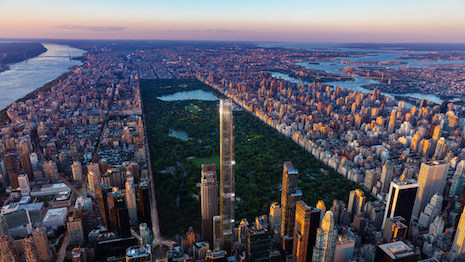Ultra-affluent individuals are increasingly seeking out dual citizenship, with second passports and international residences seeing strong demand.
Knight Frank’s 2018 World Wealth Report found that the world’s wealthy are global citizens, with about a third holding a second passport and 29 percent planning to acquire one. The report predicts that the trend of assets being moved outside of a home nation will not slow down, as many wealthy individuals look to guard against local capital controls.
"Global families – and their businesses – today span countries and even continents," said Dr. Christian Kälin, group chairman of Henley & Partners.
"Acquiring alternative residence or citizenship is a means of participating in and moving through this interconnected world with greater ease, and we expect that the value of this kind of mobility and access will only increase as the tendency towards isolationist, immigration-hostile policies becomes more prominent worldwide."
Worldwide wealth
The population of individuals with at least $50 million in assets grew 10 percent in 2017 to about 130,000.
Around a third of ultra-wealthy individuals live in North America, making it the continent boasting the largest numbers of these consumers.
New York in particular topped Knight Frank’s rankings of cities of wealth, which takes into account the current affluence of the population, property investments, lifestyle and their projected future wealth performance.
U.S. cities topped dominated the top 10 rankings of most affluent populations, with metropolitan areas such as Los Angeles, Chicago and San Francisco having the most households with incomes of $250,000 or more.

New York's Central Park. Image credit: Extell
Despite Brexit, London came in right behind New York in the overall city rankings, thanks to aspects such as its lifestyle and future outlook. The British city has the most five-star hotels of a metropolitan area.
However, cities such as Melbourne, Australia and Dubai, U.A.E. are the locales where overnight visitors spend the most, pointing to robust shopping tourism traffic.
In real estate, Knight Frank’s Prime International Residential Index grew 2.1 percent. Guangzhou, China had the steepest growth in property prices, with a rise of 27 percent last year.
Cape Town, South Africa and Aspen, CO came in second and third with 19 percent growth.
The affluent are highly globalized, with four in 10 sending their children to school in another country. Twenty-three percent are expecting to buy a home abroad in the coming year.
Today, the ultra-affluent hold total assets of $26.4 trillion. One of their main concerns is the passing down of wealth to future generations.

Affluents are concerned about passing down wealth. Image credit: Merrill Lynch
Even with the worry of their wealth atrophying as it is inherited, wealth advisers say only 53 percent of their clients have a succession plan in place.
Aside from thoughts about the future of their wealth as it changes hands, the affluent are also concerned that terrorism or cyber crime could impact their finances.
The United Kingdom has traditionally been one of the most-desirable destinations for the world’s wealthiest people, but in 2017 the country experienced a larger outflow of high-net-worth individuals than inflow for the first time.
New World Wealth’s annual "Global Wealth Migration Review" which tracked the movements of highly wealthy individuals around the globe in 2017, found that in contradiction to previous years of growth, more of the world’s wealthy are leaving the U.K. for other destinations around the world. A confluence of factors, however, including political turmoil and rising fears of terrorism, has caused the country’s first major outflow of HNWIs in recent memory (see story).
Asset allocation
Art has unseated wine as the top-performing luxury investment, as prices of pieces sold at auction grew 21 percent in 2017.
Last year saw the sales of record-breaking works, including Jean-Michel Basquiat’s “Untitled” and Leonardo Da Vinci’s “Salvador Mundi.”
While ultra-affluent collectors tend to be driven more by desire than returns on their investment, most categories saw growth in the last 12 months, with an average rise of 7 percent. Aside from art and wine, watches, coins and jewelry saw some of the strongest growth with single-digit percent increases.
According to a report from UBS, 41 percent of art collectors have never insured or appraised their collections because the hobby is not viewed as an investment, but rather a passion pursuit.
In UBS’ Investor Watch report “For the love of art,” the financial advisor surveyed art collectors to better understand their motivations, finding that an appreciation of beauty and a want to nurture creative talent is a driving factor. Also, despite fine art being viewed as a secure investment, art collectors do not partake in curating a personal collection with profits in mind (see story).
“Volatility in the art market has been driven by prices of post-war and contemporary art in the last few years," said Sebastian Duthy, director of Art Market Research. "After a depressed market in 2016 caused widespread concern, consignors were tempted back by auctioneers last year.
"The desire amongst wealthy art enthusiasts to add to their new museums carried on through 2017, while the appetites of great institutions such as the Louvre, which opened a new franchise in Abu Dhabi, put more pressure on supply," he said.
“As prices for the very best 19th and 20th century art continue to hit the headlines, there is hope within the industry that the sensational Da Vinci sale could attract a wider audience to Old Masters in 2018."
{"ct":"vuEalYpNdkNazR1+GPntcOkDaZMYa5YziBEv+vTGmJfb4Pb1ZTrW3tRw6ENWl05YnRx0nR9EAlJVqSJIu7fPkAL4zBqevL\/3rDLjH08cYtTCJ+gmQKggcx3lpkkIdkYkU9gMlzDlHZwtg3RFm\/uW3MjV9k0oy5pHk1tktiv6IwMt1rcttM7wlXz3ecEzXB8W\/YEgCK1wdd0dPDXQ8cIhl1wtdHWWE9f8Wm8eK\/V9Xpwd4\/CypzpF\/NThPicH0pxutwjt7FwRfsPsPj6MkKS+CmpTDJJwKrvGMhB7t5qm12FZ+pcNQE0Zkd0NF+QnhSeZ4rnSnd72RTfZiTcfKYdvYJsYW5o+DyOXQ7CGfv4Jypb6WNzIdA7sJ3CFcGslNKla2wy49u\/xNDSuXc3cyOL3f37HdG\/EkwTOFUX8UH0wlYzntDIS1SW+DD7d6WI+8doIM9VSIAsDKxEYaGLbwwl0AhCdkrLR0I2UpUT+m2KEYOa9Dpz82brvtJ\/CVecK+TUi0zQqV+WZxtnTKvsqXraSOuH+C8SjQBy+VFcbHAFM8uIr3m48zN6BhB1RZ+SSnAk9kkxZzzMjkbQWQF5pqiMc+YckhGihRs1EA\/SonG1HwzX14skWPAlB+nAWlY0fwPkHHtNtCsgFI9jZmxdtTwg9ftYrNOHxIuJP+ljTCQ2viRt+Ddi3vlEhk6aTyx1Y9WFbGKXo\/\/tYr285C2wTBQJGaVRMc6sNEZQpJkfEs7Zazxi9fip8Ok11XyWc10LVgE2YfY1zXQdbhoaZjuqszfDJ\/IQKIcCV3Ipr6YJddqhXLxarRwmV5AJz35uqEqF+hxp0U0lFP4v8IeSNRT\/k\/byBWqp2JfnJ93YOswPntcFGvs\/JoFTidk9LPRSluCEInf4H4CqH7JoZ87WIOOS35qm9mRDndaQJy59106Z9+RSRl8PMQ3LE4ZV1OtZlVx73OI6uqEt9JA0O\/61JotbUMhlFqx9sgz8HQsZbUBBxnNAMWaVPe0SJD+6qnDS2zQ9nHduBqYP4+fxrh3HorXd1y84d0mBuKgL5LTOhVu08OYvJ\/EE10+g2MNhj9Vr\/eacaC\/ZXyKjrNDtTYNYchfEjjebBMSvQq9x1nTNLkb\/Hb\/8QoA+h51Ffq1X05C1GsUbJsCwVQMzvjvSsvGcKr4jpST60wcT46+2gM0Pr\/vKmMf463JHDDmXEwzgyJ8Y6jyEtIFfAQmghhvOMBWMepzKS+JYnEHd2r+hYjDnXR5EZN9FzFHwyo3gUVATBpGD29W3VT+D6+BOT10WO2+HyjV17xsLFd3mUBHeyuozVEBPV++Kg1DVakzvAwNIcd3qEkWfPJ52kzSC9oSJiaWe7y31A7p8yOISrfjbAHslMtna6SrZWq1Bq1Bdqr8JnKhmf05EyttLouFZnNEZz7Vhxv2\/fkPKciqSeZhefWAyLFDnsHZQ+MSb8CKWP\/xg5sBtT\/H5eYDhcQl4HhlPWhJM8\/l7g3u2NhNLJDuGbYpXLk9f1g9hn+WA+R8Cjsnsaa0UyrZYDO4azTee0kPV7Gk6SPFEimxcPTpGj05SUy+OXz56FDyJ45hgGetDPXxJxFRYAnUlDLwxLoWQKzRVYkgFQg4decnbZeISZDu2A7VU8v213udUBXXdTpRYFZiQC0jGSeqTDky8TL92scYGmQnWfjdV0Mdvb0voCf71wES5IjtgXqrku0T2pOoteIYzSDNnq0Nz+NFOhn3DFDCtrSygaY9lBELr59QY3aYBNM6q6h94erTVlFuMRT3X26Ts\/sLFCc4C8xnXd5VcpScCIHMyZWHIvfuxNlJWS+Be++Es1FSmOlhVO1k6JPELZWvEQ\/\/gM61sA7XAr1ZxR6lNxjLVdL0WsuViZlk4h4pMNQWEwR\/scaF4tZ2w2\/hWCBCWzpAI\/cTNP6hihL9AEah5q2Ad5ctnbB\/1DnaZaj5UZ7MrwfesKjLgX1TI+BIFbsNBJt0PBvvwZSYmopJmvzEfsRIQYMuNrke11jpXdZ6Clm8Xzox5yKfMRlkwdNV1tbpaifTEOTUsfFIO8mfQymVonZnPbBeRCVMCCbRxbJ97Kd\/HpsGzA2m4I197oFZmo4v+tQmrz13pzEU\/Z\/GLVatKmxPPBeuZhVXxBbDLGtnVD4mUi5vIKyELf4VU5ZVIgQTFaMjUdcEEsPgP+dKhSTqSXLfapOXXhXesEkWstk+3cTAObmXLZZf464Uuao095rB8l5EJb+iJIFVeCUL9q5WLCr5n6QvmOoam6TEwNQY6D9yYFclk4srAddEWUjYPc1D8LGbz\/ilMbO9WnBeqtecQ5IlmQXf6HG9H6e6d2NvI6\/WblmhBTlF3RTmj7P4oFmMUg9YC34uYsc2z9Mi6jAn4M87ieHHRQUjDj1KWgQOIgBVtWzWh3CJK70jTAEYwLJmjKV7vh8C5wHUfebx0JP9HkxWuhjp0+S4q5MB\/7RLhEvGioQSD2xbUe7qV6Bn6HacYi2KY3NRdX87UU3rxJPiZ2veVBe97abKcwA9misgxsypiqYN2wXmgiJHR4G8J4xFUMibIPeEXePr6p2KiIEBqbY1p5VcsNnl4N9LeyV6LYySck\/TUSJQRrBfu8qHvDvUj20FBeiX5ojjF4qIqsH1p8f6wSPKndqrs37E4sF8mDunkP1JKh8J\/uvZHKTVBS2PO6\/lrs\/VtBB+YxODpJMisevvnlpFP+jILQBnn162\/CEAuieqPvF\/Sj5dMFK6sITAIkQQjTT6mMKdDp23\/erK3tlWGCbeK8lX4oAqO78L5pX+LU415b5ftX7MTUZy8Z5VlZgnFpnHu\/R3SNxrCl72OG+3aGoitG8SDc\/gPJwuGLW5zgmnRm8u2vgw1\/+dwilxP7UFexNN7pgqS0Y\/W9xtqpuB6SpV4SKf0rrUnRO3y3bHVgueFRCZ9oOcvD0MlbPx7bWGHBeRUFKz07eGE0VREcUbSypIvVu3n4CARdcCYxIT6hDu5TeEgdzz5YFpTvy1NuRjTE3P4KTzrbjjvbauTIghW6iSXdUKQJL2en2BMWwDIRNWHNGDQ5vTbrwx1J0kRLBpoV4JmDRMHKYk0A5cuYAID8HxX2MV7jjjaSYTf3n8D8hYnSKlWdaAtClEmgUDzZXmXwqYcRTjN4jVfChosq9EdTBibN8NVZEUMnZYa+reRk4ja8\/wgsjjxbCa7Y50EASWwVUC4db7Id6mOwCx8nuNlCT17hdO3AUkyPzUEysU7u4\/Vbs4mMxHCA7IyE2y3V\/ZK32TK\/UVmeQSh8YTL6A9Hh2bWf\/8YnMNjHMHtSEc50OxNg3xKhUDfyVCiW2w2IF\/6fFx6hw\/OB9By\/YbhI+rzioAcBmQR2EUYSbb\/OQ\/OWE4\/h7PIDOEgog22OqLB9QZA68H+RhVNgkZSBnXebUrlFcbeCMWqGg4DeX5BInHSwOg7LFpmlhBZ5WzCfUADD84Dr64asGCNVd6AD\/dCJW8tpWh3a3dfF14CHaHoZccEcb52rx0bTrO\/Uvdpr6P+kdQ+z8a0qMnBMjjQQorOWUZ6IFPu54S+Xe6zYkrGaTcqtayG1xBAmxd9wrvh55cxN3J7XfwS4BJV55NlNWIjBvZhwjzTGtQ3DLr6hgPvuVhK6nUFrcNlA87A+rFMEclfS6AdtaIeOAleXh8Fbhs0r3M8TD0+8QFdvDQPRhN9MFHPuRHjkxGHzbqB7a7J8SuwmEjaGlix925jbM6NJGPv2VGLT6FNwGF\/V18Z3X5NpPm9mqr1hxGGMUBZ+51XHxSUQdU2RAlTqCEwa9dqa9DXxJoDECNuMAUeIQSuisS3IlpFz6bI3ytj2Wcm8bndWeNedslzP7Zg+jw6df\/7Cz9Nzupg0sWRv+LM0f9ctcve0oI9RDDHPU84uPEezfYQRPYiDdrEMqu7Rzxvp3BC2qnLVG9DsRyhFN2b2Ybl627A04\/F2NcrCBO9rmF1QFkI162gWUrz8qh+kfObJgG6pJta1APsGXmhLuDAhq2sCEfbxoyRtBQMLMO0sbXNgBbkpgve2E7wYjR0PB7CuzkAfyAD3Cg2XH4zvM\/85L0tWKsDuvv7IBoRLwep7noCpP1DdSjybVB0LC5Bunc7FrSws8Xc4sfub58GDe2\/8Bpodl31PVZPFGp4PLvrZYucvmzqvdFnpSIatbEEzSr2hX1kbK+u2Vt8bFHL6yYqah\/Lie9C8FJ6ZQaO4Fgvo1wWYiNFP5yJNyzFOecA5xUM3mFwGEXyARw1GQB7zf79O\/xRHx7R2LJQPw2HUGY4r19KJVTCqWxBV7SG0kD\/wxV9SAhLaPOxi570bC9DWhGLcjgEpZiqKNFW7W6fE77EUxJ3dW6uI7h9o05MdRgRapV+qZCZH83Xa4L4fGn4K4JLPybkljkugyM73Z\/AF3xcr4QGn0uTel2v3WSMG5ac\/mz4IkKedXgC63BFgfvH\/NiQUB6JLG0\/oveICVcCI3nWpMxcnvUCPNNW37rO2CL\/b5Ku2H1bYr\/MDJatmZSomOoc0mIPSE1TfflWlfQel5MZa1HKe0wnN1b\/TxNHU9fes2ahq2DPv7h8UganNwwkyHEsyKA2wEUsyhL2ss9r5u02n62V4USGI4\/nUg8ckAOKiii66c0SvL5mSrCRhYIxpJVmRFuZhndKJ\/4Mg9Hzmc3uFQ7rV75QXRumS8VOfT6BfzCoFHwz7MxMqAh4KFRXuwpCu8kVzkS3+2azz+wJDaUYHnHDHnnGTLlMA0omgITKthP1MkU5JILUvSkv35oh9klklx22WdQpT91OG92ZRP0G8I8ccIhe65O8wyZSk6jtNPf9NVfWMnD6C2kqE1xNWT0N1zjoYFA33V7g3LxlI96DDe17RBsIeHQvxsy0965zjwnuyqIV0wHHNHnJbf33+P2Ju68plYucDCg7OpSYwslywtuRQw90ttgrQcgWR6LJHd3NMRUIzcy52veSshByATKMg0TyArteqEY\/V1Ga9xIAdWtqd67Gb68BMQ\/aY3Jk8krrT1ZazPnHHCWHW3TOuOm\/v0FPtVHaS0iQNOEcHePMBv9\/h0JeWeFQ7VjCIeA\/AruJ1MTDg\/LDfI+KwK0VLAmgyHi6zbdjhRJoy+1fewDAOhQb1SltQcMY4UxnGMMiQpdD54GtMthKB3Zo9XlUy3aGblqAgpGt48g0gZ63R9iKW4ejHu+tPlQUOpWYBP4xCXYyWKIwLDKbUIbyes4nzTQT1vprA9CeVCRs1uJfpgWDPxwVZlq4XxckdQsDITKM0qHMFpxbvFybxik1LP1fOXBOx+H7atUYWPOBp75pahL2gqJjerpKvmMhbsKt\/HNmweiNCb6N95zJZR59aB8vk0gWZ+7IVDpCGEV3CgpfFh61nIFoK9LAM1pjcramXDtiuB5RZ3Gy2fFRAMgQC1t8l9RJSiaf7qwLQCJ1bAQ5GLh\/ma4QOj2HqHgZicCGVo+zB\/dIffY2b616WhdgwquTMvpJtopmlhHSElAxX8cJUcczIbdXKfVM\/9LDCzWhM+eRVfzE59iAlYnYSo1Mc2tOZHhVjREniIlM\/7s83rNg\/xfTDX+HbTgOb3GJTbX1Tfpzaw9IjkpXdzj+woIK9Qni50CtuD5cQ3RY+qn94AVAflVN5kEAaJlO5+w83+Y53CZxGPELsRGw8vhWn23YGNM3SB0iG7PLnT4Ep\/m774K1C73PFe8Mll7rnqnOdySbtE3xZfos1oRNyB\/G8GIiE2jx77pS0tri\/7TQLnGDo2ljQNSwAggHjKz+Ovfr7Hpqex7Z1S2iH6BWCIqI9Azdiv4Gr7AQJd5IB5hxmE+E7U3ISyTTokCxAnqza10Rc2cZTKzEjf3T2M2vNVLI80SGJTEKk5eI+AFY6MyMdDg0s6GGqjlt90nSzv7OLUXPYEVxNZl6FuwTe7xWWDTQo6EdfXZzG3fXhcUjOBV9BbV0WCMZJm\/i0etY1ol3SoB6joMOsG2s9ISkQfRV0FBC0GB4cFzKOXZL3zjab7m1J986xmwGWvib5H+7ABfvUT0EL\/YJwxoooSD8MwssG5E1uDfuWGC1MS4MG4BTET73daexau9YWcmRj77Vq0inJqyt3bzAcpYmzpgfCnQN9KtGOu94Tu3CddnsPxCYXnYf7L89327KlMymXXJNUgD\/YhByDgeadZR6PuXGVJDjLWZ6UW6aPZysJz\/QTMkqhtK8R5IpDBVWnT58zp7kwe47nriOlvYd+7V4\/WEIgjbE9uS5zSbYppLtbyDqC4YmiRj+DDyYA9lwGx4N8l4WnC51+IVVrQjd7cZzZbs07jR2gC3hUJsge\/6o1763TR0UwboqX6hip+thnXQ7IB9K8XqOSTr5eqd3ixbN5TfRhi7XmYFID0KNWBxlA2eBbRMvpOXRcpWcasQW\/Bqh9z46nc8TC9+tgWuMJGNyJ3dFTcrjnepfmrXWLlIt1DvPm7GObmODfuD62eenzy5HDeBuTI69aLh5Q\/gsfXQf\/1bMFW\/pE5sc4rKDr3rdFQkMj3pbC7KNTDRRsfuoAInBtysfXgtsIRWXcalu72zK\/zg6Tn4kZ\/hBiTj8zwGVGgmcCWJf0SUTfwMBOBUZ6U3jaYWf3bqXY\/6uiCemzzTcuHudg9Vid2Lb9QIDy6TX3cGyuSHH22faHN9yaVLB2Aeogksq2dkyTB48\/wnhqG+d81sO12fk20z0TKJZ0AloaMQBLFW\/mhSzgc8MzzN9PjXzBTjCTivgj9lrOYlEyXcAdvpXmdX6vm4CAQZYZzsXoerqXuwmU3HxCySZXhUdQNrWEqGD+8jMKcNK+NagMfUepUrI6LxZ4Z6soTYrqY6GnHSPGyLolTX5ygtLrdX2i\/D5EX2etLzGzTwV+ygZ5yiOk74h2k8mIboii3HF07hgoTYJvSliEn699\/XTOtmRS7Nx9yABzbz5C+LtlqiswxEefFKYVFgD\/oA3\/T9uwPNKt1zKQf5ZLooBQwskCDGKMGN2RGxVUN45tc1gh9wLnRjglsxWV5tN5+Vw9kMJx7yHaP1AkXMiw6MdMIdiQZbgi6SLnhxxRcJzjASq6AdF9xID+m292LFPr6fGgskhR1WNJaYJ\/LfINMeL5HbZD8gIK7v8OayioCVKfDi+rQz5wZGdC8DAFZZcqfEKm2HY5U2aY0oGLz5py3wJxux4DZPNuSyzMiJHUn\/E8NlXPTky9LFbX66aDH2Jr2ofcGrBbFz73YouKtRF+l7hc3E\/DoARVWpyrxG9ttdd99jmc9jrVO3Rj2apLEuLy6XFeLRYQpJdLoFT8jBKCywcxnghWLvYnDrjGzW5\/tNej9OoJih8tkpDJQsj8nrb9tDJIpEd7yaij27LKA\/0BBtY2g1pThK9D7\/9MqUGmZ924NkmD436K4ocKegNePoAqC7FntAvrSXkBKcReCncIuQhvfs5nUtLE0EGAeDL+iePbkd1Av0GJuoZhmBVA3zspojCfn3esh+7tJXK+kmPm5wcbjMau32KhRH2pM6ImGjWe+5jA2vaVyLbJfp5vU4E4XQjKWEpuawXvKJZ1ji\/MAsGl4BuM4cfkafB4aD9qDC2CdxM32rNLO6Bbo6vx0KYYjo6kHIH\/Q45VmVQ1JoBlqUKh2oit1tBIyzjQZVKyE5ryXlNwXcDHk\/zajjJ6fd9CO8DP3hWDf\/7pr2TyKWEa7s5zlp\/RxPd5jh7+eI4G1emiGx9VGMn050e\/XKbLsZvbi\/KJCR2rjsabBc6qnw1dSJdk1xUs\/eVeNLzVrmSZEQ475UoM1L9lQRtxEIjkr7AkLc5KHDr937F\/o3I6QgaiJSXDphm\/UBcpkVg+CBq6d10d18eYWwHxcV19tP6hrzAlkgdSv6A+6lfOwpDWifMfysANHb+G6sawcQ+fHpRmeypU3dxyBopA8xuD8l5UrwS26gSAyL79GMMxZ6Qm\/ufV1MQtuT99o4TNuFdtCHNd3RsyZBP1H+yn\/MX6bW5lVIjfsQHP2zQFUEuDMsGEeea1Kp+QvUG4BXcP27C+SUz4aIqf6wj54a2WDkKin1zGnKCUjYscjr\/Y0lvTntitFsaU6DOKH8OAsmfKamiMHBatJi4MAMrLimKZE3Tj0fvL9Uf11FqpF1aKPPdCu\/k3orUAWymKfl1Q4WpPJWokALdC0LtnI1rZjnbKqCxvioJSn9zmdX8Ul\/q3WwHbHu6FuujR68ET8HaPOqH9Cu8J8o2GbmQGV7ZVL0l2vN4yaCOVys9Ks+UW\/T6ZEbTLBTy\/IVit0U0IZCIWA4EjEgK2U47jhKNrqNdiAazJ6Uw\/1AXdOheyXp7EmiSti3Sma+G1FQErY0NIvLaqXTmCi7NYAEcsYM9xlzFqICuETbv2gV1AnqVk3oa8JgVrjEPZJiumi6La0vBJ5\/opsQfsMlmFqugn\/Z0Lv+pAyT6TeniFTcvW+Z\/UkjiKETdk9DU5mZWPBllwlal9TvN4ZqyoGzlqqFY3UE\/UEMlFHRVkjpxCqTPI7cJbod5q1ORKXazX3hGQpaYHQZ4kteIYdko6C56L9jo8VT0WiBCquDlyZqNRNdDEaJnzoAVa430eMM0xBmyzp4Z0uvM8TuMbMwNWNrfIPHez0Q9X29sukJdmJhgN1FKaHN87\/C\/fJfkgy754NELoJPMMgSMAKftUqw6ENxzFQ09da+CgRjP7ZiLKvNq2xxoW6o83K7KXVtbmc6kNI\/\/Nv8FUJM02TyGGrVPCXaIAmYpWwoB8UOJqRL6q9vDcSY7f+TPVBsMQWhmQMvkl4zcGgxIkXjteM80b5IFSbvRv84dKH85yq\/zOYE+uzwtBTivKXLdxKgAre\/zg6KhluM2LscN69FP2LiYiWE1BOXJGYcIaRrHkJw0HIvcQTACFzFkCdMCfBpfTdbH32gwR5qsm6JmKG2epbUgZpVzz7ixYmvtn8\/abwrqsb1N2jnBUyH6jR4KLRNWRr83J6Qc8dDDc1U7FDwCHV+ytD2e0ptX3aXVKy553r5+klq5pq9eqIGjodqOHq3uPhAYR6AxHcug7\/mTyJk0CDFP\/1JDjrWz3sPUR2qsJjTOCu2Je221TiTTncBL9QfitMfuizh8qteVYVJS6xJ3a40QGEF8mahXoLmaYq7LMch+0YoBvqjo2YX\/QmRsJZwX9hyBg03VM6KlHbr0kDwE34lUkztUzNz+\/uWXruDA3RKvIBdrFyRqVJgJj1DjkYoYDYlxfyomWjCj6x6pfPPaES2AB0k600f1+zCkZVSssT5Pt35zrPr53Xid\/l4u0omESrGD3SdqLuTR+LUu58cXhUo+Cl1ftvXKpFpEIDHkEZqdherCGAq\/7xnQb+CB8DO\/KDZ5grUvsU4dt7aNOiSDDS+fhHL21+LZzM2e+y5E43lbRtKwNJIUlJnsRyDlwff9XAZTuLM6ceynaJ0csoA8+jyJ9yJc22Iq5+KRSXoVL9p1lPpXrPArYjWUWH53HxCWmonQyNwL\/WS1ryEt3Fq1cT9iZe2r8ZfYSmy1oq721FTldZqV5amBapakfENrEc5a3CyXeOxf85s5I3WcoCXHHdUY5h9ECW49HSswNMUzEoPozjV+S1VF48McjOYKoxf4PuJylxS8EsndhsG+uwcQ0WcnphPkwnETYqC3LR2Uo50joP39fotFU\/7h0Q4Feojs011AHZD4Bg90cmWftldVPjdWXzIfiuJ3od8W15xHBlZJdI4bo3alMy5ryQ35f3lBGps+Nu4yx2AYUm49iWmq9sx4+vUopYlHlbfucAB\/IQ5iYz4+fguYubbc5SYw+szYWyivPuhIXBSH\/jqRtkOJb+Kl7SOC8PR1oZfRvaYDS6E+yHuuhrgvEbpG2FrjhWGzWQqdz4d9\/Kgr0tmZV\/TW3JX2cQ6MPoLqQhGi4Mn3aypojZUxktp2HELrVUlce+Lvd2x+1SLBjX5mcnvFrRJz6dGnRGt7hcwudEeNNRf5Y4EooZPCy\/og4nR2ICF\/AtBkV2ezasa\/QqnfM5NyegbQkOzTW37x7F\/hSXdwJ8Vs03ZpHSq4MTR4vCq+5ozFrW+yc0qufMIZIOXglZI4gMImEIyIE1JflV6v4X1rHIYgb0pM+DmBA2sNybeU5","iv":"5d6083fcfed298f5c87dc6351fb9660c","s":"19666693c9341da2"}

 The ultra-affluent are global. Image credit: Printemps
The ultra-affluent are global. Image credit: Printemps